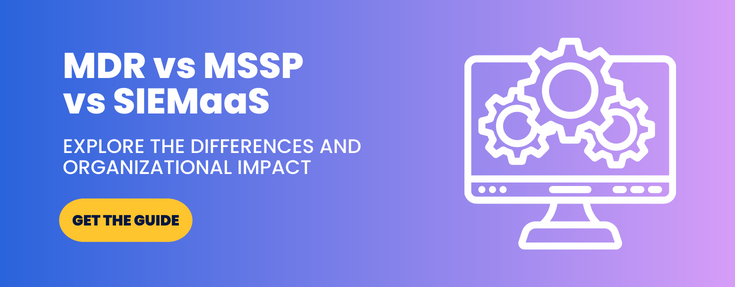MDR vs SIEM vs SOAR Acronyms Explained

 By
Jason Miller
·
4 minute read
By
Jason Miller
·
4 minute read
With the growth of cybersecurity and an ever-changing marketplace, there’s been an explosion of acronyms in the tech industry. Companies are continually innovating to ensure protection from threats on the internet and cloud. Naturally, it makes life complicated for the average CIO. Three distinct but related terms, MDR, SIEM, and SOAR, are causing substantial confusion among the IT community. What do they mean? And what are the differences between them? Let’s take a look.
MDR vs SIEM vs SOAR
What is SIEM and why is it useful?
The SIEM acronym stands for Security Information and Event Management. The purpose of this technology is to gather as much network security information as possible, apply intelligent algorithms, and then use the output to identify significant events and incidents.
No human operator could hope to monitor an entire network manually, especially at a large and complicated enterprise. SIEM, therefore, is a kind of automation technology that takes over network monitoring by recording and collecting information, logs and packets. It monitors the flow of traffic through the network, paying particular attention to patterns that could indicate a cyber attack. Then, using a database of information and artificial intelligence software, it attempts to learn specific or unusual patterns that could suggest that a particular network is under attack and alert IT managers and security professionals.
SIEM is similar to an advanced virus detection system but with a much broader scope. It helps to identify a large number of threats to an organization and can train itself (to some extent) without the need for continual tuning by software analysts and engineers. It’s a time-saving method for cybersecurity personnel that helps them process the constant influx of new data on the network and leverage it to their advantage.

What is SOAR and why is it useful?
The SOAR acronym stands for Security Orchestration, Automation, and Response. Security automation performs a similar function to SIEM but at a much higher level. The primary focus of SOAR is to gather and organize information in a way that cybersecurity professionals can easily manage and process.
SOAR, unlike SIEM, takes information from a wide range of platforms and delivers it to a single, central hub that engineers can then evaluate. The idea is to standardize case management and help investigators naturally incorporate incident investigations into their workflow.
SOAR also automates the process of incident response by analyzing and categorizing each specific incident and then deciding whether there is a need for a human operative to do more work. SOAR helps to eliminate the need for people to respond to constant alerts manually and enables engineers to categorize different threats for evaluation.
The system, therefore, offers a suite of additional services that not only identify threats on the network but also gives SecOps more tools to carry out their work. SOAR integrates into existing workflows, helping to make network management more efficient and automated.
SIEM is intelligent software, just like SOAR. But SIEM is prone to generating more alerts than a team can respond to. SOAR helps to reduce the number of alerts and also make workflows more manageable.

What Is MDR And Why Is It Useful?
MDR, or Managed Detection Response, is another type of threat detection system but with important differences from SIEM and SOAR. Organizations typically use MDR when they want to be able to speed up the detection of threats on their network. The average time to detect an issue in a company is about 200 days without MDR technology. However, with it, companies can identify and deal with problems as quickly as a few hours.
The main focus of MDR is on detection, not compliance. Organizations themselves don’t usually implement MDR. More often than not, it is provided by a third-party who takes over the operation and running of the system and does it on the company’s behalf. MDR, therefore, is ideal for companies that don’t have the internal resources to manage their own threat detection systems.
MDR comes with a host of monitoring tools, security tools, and perimeter detection tools that attempt to detect when an intrusion occurs and then prevents it from damaging the rest of the network.
The good thing about MDR services is that the providers do all of the testing and sandboxing for you. Suppose, for example, that your company falls prey to a nasty piece of malware. Instead of having to live with the problem or hire a bunch of security experts to remove it from your system, the provider will do all of the hard work on your behalf to get rid of it for you. Usually, you don’t have to lift a finger.
Which will you use at your company: SIEM, SOAR or MDR?
The type of detection system you choose for your security depends on the position of your company. If you have the internal resources, a system like SOAR can give you a lot of fine control over how you manage your IT security controls. But if your organization doesn’t have significant resources to plow into cybersecurity, then you may want to consider MDR, a more affordable option.
MDR, just like other threat detection systems we’ve discussed, protects your networks in real-time. Third-party IT professionals monitor your network, interrupting attacks, if and when they happen. The good thing about MDR services is that they will only inform you of an alert if they believe that an attack is real.
SOAR and SIEM will both churn out alerts with varying degrees of relevance, but with MDR, it’s much more likely that any alerts you do receive will be relevant. What’s more, you usually don’t have to lift a finger: your MDR provider often sorts the problem out for you remotely.
Currently, less than 2 percent of companies are using MDR support. However, Gartner predicts that the number will grow to over 15 percent by the end of 2020. Not only will popularity grow among smaller companies, but also among mid-size companies that want to keep IT expenditure down. Many MDR solutions integrate with existing software stacks, allowing you to continue operating as usual.
How BitLyft Cybersecurity Can Help
BitLyft AIR® merges SIEM, SOAR and SOC, together as a cohesive solution known as managed detection and response. This allows our clients to focus on what’s most important, their business at hand.

BitLyft AIR® helps businesses of all sizes to safeguard their systems, protect their networks and ensure no cybercriminals can steal their data. With experienced specialists helping to manage your business’s defenses and answer any security-related questions and concerns you may have, it’s the ideal solution for a convenient and flexible cybersecurity solution.
Our services aim to provide you with a simple no-nonsense solution to keep your business safe from online threats. If you’d like to learn more, don’t hesitate to get in touch with us today to speak to one of our friendly representatives. We’ll help explain the services we offer and how they can be customized to your exact needs.
